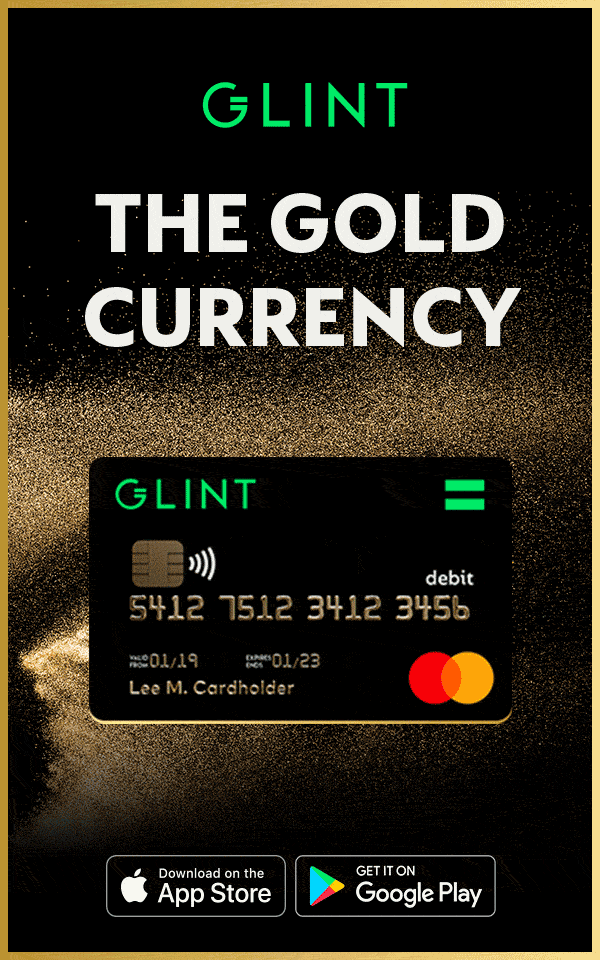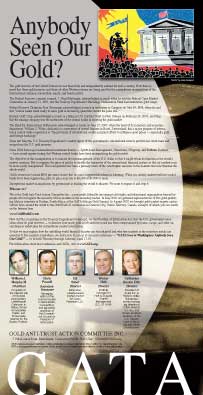You are here
BIS annual report again verifies GATA's calculations of the bank's gold swaps
As usual Lambourne is too modest to note that BIS annual reports REPEATEDLY have confirmed his calculations of the totals of the bank's secret gold swaps.
* * *
By Robert Lambourne
July 1, 2025
Last weekend the Bank for International Settlements published its annual report for the year ending March 31, 2025:
https://www.bis.org/about/areport/areport2025.pdf
It includes some detail on the gold transactions carried out by the bank and in particular at the bottom of Page 195 it confirms that the gold swaps outstanding on March 31 were 10 tonnes, reasonably close to the estimate published by GATA on May 23, 9.5 tonnes:
https://www.gata.org/node/23855
... Dispatch continues below ...
... ADVERTISEMENT ...
Blue Lagoon Resources Added to CSE25 Index,
Is Among 25 Largest Companies on the Exchange
Company Announcement
Thursday, June 26, 2025
VANCOUVER, British Columbia, Canada -- Blue Lagoon Resources Inc. (CSE: BLLG; OTCQB: BLAGF; FSE: 7BL) is pleased to announce that it has been added to the CSE 25 Index, the Canadian Securities Exchange's benchmark index that tracks the top 25 issuers by market capitalization.
The CSE 25 Index is a subindex of the CSE Composite Index and includes the largest companies by market capitalization on the exchange. Inclusion in the index represents a significant achievement for Blue Lagoon, reflecting its growing market capitalization and strong shareholder support, and providing increased visibility among institutional investors.
"Being added to the CSE 25 is a meaningful indication of the progress we have made," said Rana Vig, president and CEO of Blue Lagoon Resources. "With a fully permitted project, funding in place, and gold production expected to begin this summer, our inclusion in the index is a reflection of both market confidence and the strength of our strategic execution." ...
... For the remainder of the announcement:
https://bluelagoonresources.com/wp-content/uploads/2025/06/News-Release_CSE25.pdf
This table summarizes the level of gold swaps since the BIS began reporting them in its annual report as of March 31, 2010.
March 2010: 346 tonnes.
March 2011: 409 tonnes.
March 2012: 355 tonnes.
March 2013: 404 tonnes.
March 2014: 236 tonnes.
March 2015: 47 tonnes.
March 2016: 0 tonnes.
March 2017: 438 tonnes.
March 2018: 361 tonnes.
March 2019: 175 tonnes
March 2020: 326 tonnes
March 2021: 490 tonnes
March 2022: 358 tonnes
March 2023: 77 tonnes
March 2024: 72 tonnes
March 2025: 10 tonnes
The monthly estimates of the swaps published by GATA reveal a pattern of regular gold trading that is often substantial. This indicates a much closer official interest and involvement in the gold market by the BIS and its central bank members than they generally admit.
The BIS has given no explanation for its gold swaps since their existence was disclosed in the bank's 2009-10 annual report. Regular questions are asked of GATA about the purpose of the swaps, and as far as GATA is aware no further disclosures have been made since an article was published in the Financial Times on July 29, 2010.
Below are that article and an article from Business Insider following up on that article.
*
BIS Gold Swaps Mystery Is Unraveled
By Jack Farchy and Javier Blas
Financial Times, London
July 29, 2010
https://www.ft.com/content/3e659ed0-9b39-11df-baaf-00144feab49a
Three big banks -- HSBC, Societe Generale, and BNP Paribas -- were among more than 10 based in Europe that swapped gold with the Bank for International Settlements in a series of unusual deals that caused confusion in the gold market and left traders scratching their heads.
The mystery of who was involved in deals with the BIS, the bank for central banks, and what they were doing, has become clearer.
The Financial Times has learnt that the swaps, which were initiated by the BIS, came as the so-called "central banks' bank" sought to obtain a return on its huge U.S. dollar-denominated holdings. The BIS asked the commercial banks to pledge a gold swap as guarantee for the dollar deposits they were taking from the Basel-based institution.
When news of the swaps, which were disclosed in a note to the BIS' latest annual report, circulated among traders this month, it caused a sharp fall in the gold price, sending bullion to what was then six-week lows. Gold has since fallen further: it was trading at $1,164 an ounce on Thursday.
Some analysts speculated that the swap deals were a surreptitious bailout of the European banking system ahead of last week's publication of stress tests. But bankers and officials have described the transactions as "mutually beneficial."
"The client approached us with the idea of buying some gold with the option to sell it back," said one European banker, referring to the BIS.
Another banker said: "From time to time central banks or the BIS want to optimize the return on their currency holdings."
Nonetheless, two central bank officials said some of the commercial banks also needed the U.S. dollar funding and were keen to act as a counterparty with the BIS. The gold swaps began in December and surged in January, when the Greek debt crisis erupted and European commercial banks were facing funding problems.
Jaime Caruana, head of the BIS, told the FT the swaps were "regular commercial activities" for the bank.
In a short note in its annual report, published at the end of June, the BIS said it had taken 346 tonnes of gold in exchange for foreign currency in "swap operations" in the financial year to March 31.
In the same fiscal year, the BIS took three times the amount of currency deposits it had taken the previous year as central banks around the world became concerned about using commercial banks for their deposits and turned to the Basel institution.
In a gold swap, one counterparty, in this case a bank, sells its gold to the other, in this case the BIS, with an agreement to buy it back at a later date.
The gold swaps were, in effect, a form of collateral against the U.S.-dollar deposits placed by the BIS with commercial banks. Gold is widely regarded as one of the safest assets but has not been widely used as collateral in the past. Mr. Caruana described the transactions as "loans with a guarantee."
Investors have bought physical gold in record amounts during the past two years and deposited it in commercial banks. European financial institutions are awash with bullion and some are trying to pledge gold as a guarantee.
George Milling-Stanley, managing director for government affairs at the industry-backed World Gold Council, said: "The gold swaps commercial banks carried out with the BIS demonstrate the effectiveness of gold as an asset class, because even in the depths of the worst liquidity crisis in living memory, institutions with access to gold were able to make use of it to generate dollar liquidity.
"The issue also feeds right into the current debate among Asian central banks about the lack of assets suitable for use as cross-border collateral."
Last year, CME Group, the world's largest derivatives exchange, allowed investors to use gold futures as collateral for some operations. Other institutions, such as central banks, had begun using and requesting gold as collateral in the past two years as perceptions of counterparty risk have risen, bankers and officials said.
The gold used in the swaps came mainly from investors' deposit accounts at the European commercial banks. Some investors prefer to deposit their gold in so-called "allocated accounts," which restrict the custodian banks' ability to use the gold in their market operations by assigning them specific bullion bars. But other investors prefer cheaper "unallocated accounts," which give banks access to their bullion for their day-to-day operations.
Officials said other commercial banks obtained the gold from the lending market, borrowing bullion from emerging countries' central banks.
*
European Banks Lent Their Customers' Gold to the BIS
From Business Insider, New York
July 30, 2010
https://www.businessinsider.com/european-banks-lent-customers-gold-to-the-bis-2010-7
Although it does not appear until almost the end of this article in the Financial Times, "BIS Gold Swaps Mystery Unraveled" --
https://www.ft.com/content/3e659ed0-9b39-11df-baaf-00144feab49a
-- the source of the gold provided in the dollar swaps with the BIS is coming from customers of about 10 European banks that are holding their gold at the banks in "unallocated accounts."
"The gold used in the swaps came mainly from investors' deposit accounts at the European commercial banks. Some investors prefer to deposit their gold in so-called 'allocated accounts,' which restrict the custodian banks' ability to use the gold in their market operations by assigning them specific bullion bars. But other investors prefer cheaper 'unallocated accounts,' which give banks access to their bullion for their day-to-day operations."
The European Banks, including HSBC, Societe Generale, and BNP Paribas, were desperately in need of dollars because of a repeat of the short squeeze we had previously identified. Their customers were withdrawing dollars previously on deposit at the banks, which were unable to meet the demand because of the deterioration of the dollar assets they held, and because of the fractional-reserve nature of their operations.
So the BIS stepped in and swapped its dollar holdings for the some of the banks' customer's gold. Let us be clear about this. The gold is on deposit at the banks, in the same way that customer dollars had been on deposit.
In lending the gold to BIS, they were relieved of their dollar short squeeze and were able to supply their customer demands. The BIS obtained a fee of some sort in the swap, and so it is happy, although it is foolish to think of the BIS as a primarily profit-motivated organization. It is more like the Federal Reserve than Goldman Sachs.
The question remains unanswered, though. What is the duration of the swap, and does the BIS intend to hold the gold or use it in other interbank operations?
Yes, the nice high-level chart the FT includes shows the spike in gold holdings at the BIS, but does this mean that it is sitting there in their reserves unencumbered, or are they leasing any or all of it out, "putting it to work," as they say? Central banks are notorious for making little distinction between unencumbered gold assets and real assets in the vault.
But it is nice to see verification in the mighty Financial Times that if you hold your bullion gold in an "unallocated account," even with a prestigious bank, it may very well not be there when you wish to have it, and the prices will soar as the banks scurry to cover, just as has happened twice of late with their U.S. dollar assets.
Or you may be asked to settle in cash if there is some clause in the contract, as in the case of the exchange-traded funds or the Comex.
-----
Robert Lambourne is a retired business executive in the United Kingdom who consults for GATA about the involvement of the Bank for International Settlements in the gold market and about U.S. government debt.
* * *
Support GATA by purchasing
Stuart Englert's "Rigged"
"Rigged" is a concise explanation of government's currency market rigging policy and extensively credits GATA's work exposing it. Ten percent of sales proceeds are contributed to GATA. Buy a copy for $14.99 through Amazon:
* * *
Help keep GATA going:
GATA is a civil rights and educational organization based in the United States and tax-exempt under the U.S. Internal Revenue Code. Its e-mail dispatches are free, and you can subscribe at:
To contribute to GATA, please visit:
Donations of $250 will entitle the donor to a 1-ounce silver round commemorating GATA's work:
https://www.gata.org/sites/default/files/GATA-silver-round-front.png








